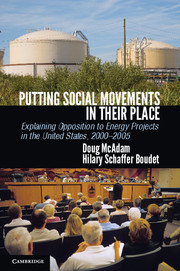 Putting Social Movements in their Place
Putting Social Movements in their Place Book contents
- Frontmatter
- Contents
- Acknowledgments
- 1 From Copernicus to Ptolemy and (Hopefully) Back Again
- 2 Comparing Communities “At Risk” for Mobilization
- 3 Explaining Variation in the Level of Opposition to Energy Projects
- 4 Does Opposition Matter?
- 5 From Not in My Backyard to Not in Anyone’s Backyard
- 6 Back to the Future
- Appendix A Additional Community Data Collected Not Used in Causal and Outcome Condition Scoring
- Appendix B Raw Data and Methods for Scoring Causal Conditions
- Appendix C Interview Sources by Case
- Bibliography
- Index
5 - From Not in My Backyard to Not in Anyone’s Backyard
The Emergence of Regional Movements against Liquefied Natural Gas
Published online by Cambridge University Press: 05 June 2012
- Frontmatter
- Contents
- Acknowledgments
- 1 From Copernicus to Ptolemy and (Hopefully) Back Again
- 2 Comparing Communities “At Risk” for Mobilization
- 3 Explaining Variation in the Level of Opposition to Energy Projects
- 4 Does Opposition Matter?
- 5 From Not in My Backyard to Not in Anyone’s Backyard
- 6 Back to the Future
- Appendix A Additional Community Data Collected Not Used in Causal and Outcome Condition Scoring
- Appendix B Raw Data and Methods for Scoring Causal Conditions
- Appendix C Interview Sources by Case
- Bibliography
- Index
Summary
In the previous two chapters we took up issues – movement emergence and outcomes – to which scholars have devoted a great deal of attention. By contrast, in this chapter, we focus on a topic about which we know comparatively little. We refer to “scale shift,” or the geographic expansion or contraction of contention. In a 2005 article, McAdam and colleagues lament what they see as the “distorting lens” of social movement scholarship. More specifically, they fault movement scholars for continuing to propound a stylized view of social movements rooted in the field’s early preoccupation with the New Left/New Social Movements of the 1960s and 1970s. This “stylized view,” they contend, equates movements with the following four features:
Disruptive protest in public settings,
Urban and/or campus-based movement activities,
Contentious claim making by disadvantaged minorities, and
Loosely coordinated national struggles over political issues.
They go on to present data from their time-series analysis of “protest events” in Chicago between 1970 and 2000 in an effort to show that all of these features are wildly atypical of movement activity, especially during the most recent period.
In this chapter we focus on the last of these stylized elements. McAdam and colleagues (2005) frame their discussion of the element in the following way: “National movements tend to be the modal object of study for movement analysts. So, for example, for the U.S. we have extensive literatures on such national struggles as: African-American civil rights, women’s, environmental, pro-choice, pro-life, among others. Does the empirical attention accorded [these] national movements match their actual proportion in the population of all contentious events?” (10). Based on their data, the answer is unambiguous. “A scant six percent of all . . . events were coded as ‘national’ in their focus . . .. In contrast . . . nearly three-quarters of the total were judged to be focused on ‘city’ . . . or neighborhood issues” (10–11).
- Type
- Chapter
- Information
- Putting Social Movements in their PlaceExplaining Opposition to Energy Projects in the United States, 2000–2005, pp. 132 - 178Publisher: Cambridge University PressPrint publication year: 2012


